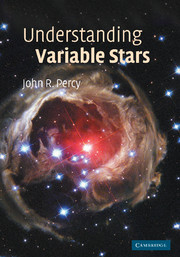Book contents
- Frontmatter
- Contents
- List of Boxes
- List of Figures
- List of Tables
- Preface
- 1 History and development
- 2 Stars
- 3 Variable stars
- 4 Rotating variable stars
- 5 Eclipsing variable stars
- 6 Pulsating variable stars
- 7 Eruptive variable stars
- 8 Pre-main-sequence variable stars
- 9 Miscellaneous variable stars
- 10 Epilogue
- Appendix: Acronyms
- References
- Resources
- Index
4 - Rotating variable stars
Published online by Cambridge University Press: 28 October 2009
- Frontmatter
- Contents
- List of Boxes
- List of Figures
- List of Tables
- Preface
- 1 History and development
- 2 Stars
- 3 Variable stars
- 4 Rotating variable stars
- 5 Eclipsing variable stars
- 6 Pulsating variable stars
- 7 Eruptive variable stars
- 8 Pre-main-sequence variable stars
- 9 Miscellaneous variable stars
- 10 Epilogue
- Appendix: Acronyms
- References
- Resources
- Index
Summary
Only in theory are stars bland, featureless spheres. In the case of the sun, we can directly observe its complex, ever-changing surface – sunspots, flares, magnetic fields, low-level pulsation, and seething convection cells – bubbles of rising and falling gas. On other stars, we cannot ‘see’ the appearance, but we can deduce it.
As the star rotates, regions of different brightness (and colour, and magnetic field strength, and other properties) will pass into the observer's field of view, and these properties will appear to vary. The period of variation is the period of rotation. Since all stars rotate, any star with a patchy surface will be a rotating variable, unless the patches are symmetrical about the axis of rotation, or unless the axis of rotation points at the observer. The variations will be both photometric and spectroscopic.
What causes a star to have a patchy surface? Rotation itself causes a star to be slightly oblate, and to be slightly cooler at the equator and hotter at the poles. But this effect is symmetric about the axis of rotation. A binary companion can cause patches: it distorts the star, and causes ‘gravity darkening’ and a reflection effect; this is discussed in section 5.4.6. Ellipsoidal variables are sometimes considered to be rotating variables. In this case, a star is distorted into an egg shape by the tidal gravitational effect of a companion star. The axis of the ‘egg’ points to the companion, and appears to rotate as the star orbits the centre of mass of the system.
Information
- Type
- Chapter
- Information
- Understanding Variable Stars , pp. 81 - 102Publisher: Cambridge University PressPrint publication year: 2007
